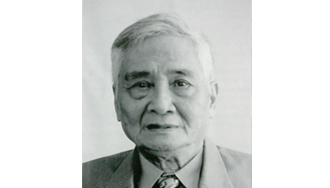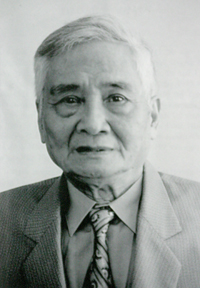
Grow up through self-study
It is hard to believe but it is absolutely true that our teacher Dinh Gia Khanh does not have a university degree. When we helped him fill out his resume, when it came to the educational level section, he smiled and said, “equivalent to high school diploma”. In fact, he was studying at the Indochina Law University when the August Revolution of 1945 broke out. The student Dinh Gia Khanh had to drop out of school to enter the world with his first job as an English teacher for high school students. After that, he taught Vietnamese literature at a pedagogical college. At the age of over thirty, he became a university lecturer on folk literature and medieval Vietnamese literature at Hanoi University. With his ability to self-study and self-train, he equipped himself with a vast amount of Eastern, Western, modern and ancient knowledge in the aspects of language, literature and culture. Some people joked that Mr. Dinh Gia Khanh learned one thing but did another. From the perspective of modern education, he is an example of turning the training process into self-training. In the teaching process, he not only imparted knowledge but also paid great attention to methods. He often told his students that they should not look at my finger but look in the direction I pointed. To serve the work As a training author, he edited and wrote textbooks that until the early years of the 21st century are still irreplaceable monuments such asVietnamese folk literature,Vietnamese literature from the 10th century to the first half of the 18th century.

Professor Dinh Gia Khanh (1924-2003) was Head of the Department of Folklore, Ancient and Modern Vietnamese Literature (Faculty of Philology) (1956-1983); Director of the Institute of Folklore Research (1983-1988); Editor-in-Chief of Folklore Magazine (1983-1992).He is a scientist with outstanding contributions, laying the foundation for research on Vietnamese culture and folklore.
Scientists always take the lead and dominate the top
In fact, for Professor Dinh Gia Khanh, teaching and research are two but one. His lectures have a very high scientific content. His textbooks were originally intended only for students' learning. But many of the issues in them have become condensed monographs such asCollecting and researching folk literature in Vietnam,Brief history of Vietnamese folk literature. On the contrary, his monographs initially came from teaching needs. For example, monographsProblems of fairy tales through the study of the story of Tam and CamBefore it was first published as a book in 1968 (Literature Publishing House), he used the outline of that manuscript to teach the subject to fourth-year students of the Literature Department of Hanoi University, courses 7 and 8 (1966, 1967). Since 1980, Professor Dinh Gia Khanh was transferred to work at the Institute of Folklore Studies, now the Institute of Cultural Studies, as the Institute's Director. There, the Professor wrote his life's works. On the Path to Understanding Folklore is considered the Institute's academic manifesto in the early years of its establishment. In this work, the Institute's Director presented theoretical issues, research history, and elements of folklore. The book was and still is a handbook for young cadres who are new to the field of folklore research in particular and cultural studies in general. Vietnamese folk culture in the context of Southeast Asian culture is a very useful research work not only for the field of folk culture but also for regional studies and comparative culture. Here, readers identify Vietnamese folk culture in the Southeast Asian cultural space through the process of creation and cultural exchange and acculturation. Vietnamese folk culture with the development of Vietnamese society is a research work on folk culture in a chronological direction. The author clearly points out the adaptation and cultural transformation in the movement of society through village conventions, festivals... Regarding the contribution of Professor Dinh Gia Khanh in scientific research, it is impossible not to mention the translation and research works of authors and Han Nom works such asViet Dien U Linh,Strange Tales of the South,Southern sayings,Strange Encounter in the Forest and Stream,Poetry of Nguyen Binh Khiem; in-depth studies on words and meanings in the Tale of Kieu... These works are highly appreciated by specialized researchers. With such outstanding contributions in training and scientific research, Professor Dinh Gia Khanh was awarded the title of Professor quite early (in 1980) and was awarded the first Ho Chi Minh Prize for Science and Technology in 1996. A colleague jokingly said that these were spectacular breakthroughs in the life of Professor Dinh Gia Khanh.

Cover of the book about Professor Dinh Gia Khanh, published in 2014 by the Institute of Literature and Saigon University, on the occasion of the 90th anniversary of his birth.
An organizer, manager with soft power
With more than 20 years as Head of the Department of Ancient - Modern - Folk (Vietnamese Folklore, Ancient and Modern Literature) of the Faculty of Literature, Hanoi University of Science, Professor Dinh Gia Khanh has a strategic vision for building the department. He considers the department an academic unit, not an administrative unit. Therefore, he focuses on writing textbooks, building a system of specialized documents and training young cadres. Although not yet a Party member, in 1980 he was trusted by senior leaders to be the Director of the Institute of Folk Culture, in 1982 he was the General Secretary of the Vietnam Folklore Association, in 1983 he was the Editor-in-Chief of the Folklore Magazine. The scientific community especially appreciates his role as Chairman of the Editorial Board of the department.Anthology of Vietnamese Literature, directed more than 100 scientists with different expertise and personalities, working for 20 years to complete 42 volumes in the Anthology of Vietnamese Literature from folk literature to Vietnamese literature before 1945. He organized and managed science very effectively, not by power or imposition but by the prestige of scientists and by the vision and heart of managers, or temporarily called soft power.
A beautiful personality in everyday life
Professor Dinh Gia Khanh is honored by society in many fields: He is a talented teacher, an erudite scientist and a prestigious manager. Hidden deep within that halo is a great personality in everyday life. That personality is shown in his relationships with his family, colleagues and students. During his lifetime, Professor Dinh Gia Khanh had an extremely happy family. His wife, teacher Nguyen Thi Dac Quy, is a beautiful woman from Hanoi, very charming and also devoted to her husband's career. The eldest daughter is Associate Professor, Doctor Dinh Thi Minh Hang, who followed him in his career of literary research. Next are the three musketeers Cuong, Tuan, Thiem, all of whom are strong, successful in their work and happy in their families.
Professor Dinh Gia Khanh was very simple in real life. In the late 20th century, many older intellectuals in Vietnam were familiar with motorbikes (with or without gears) imported from France, Germany, Japan, Italy, etc., but Professor Dinh Gia Khanh was still attached to the old bicycle that he had used for decades. He also had the same shortcomings as any other normal person. For example, sometimes when he went to class to teach, he wore a thin white shirt and forgot to wear a checkered shirt underneath, revealing his not-so-plump body, making the female students look at each other and giggle. He liked to smoke, including tobacco, a habit that lasted for a long time. That left a legacy at the end of his life, respiratory failure. But inside that simplicity and everyday shortcomings was a sharp mind and an extraordinary ability to work scientifically. In dealing with colleagues and students, he was tolerant and generous, and he hardly raised his voice at anyone. In academics, he almost never argued fiercely with those who did not share his views. All of these things created the personality of Dinh Gia Khanh, the personality of a person who lives forever with spring.
|
PROFESSOR DINH GIA KHANH
+ Work unit: Faculty of Literature + Management position: Head of Department of Folklore, Ancient and Modern Vietnamese Literature (Faculty of Philology) (1956-1983). Director of the Institute of Folklore Studies, National Center for Social Sciences and Humanities (now Institute of Cultural Studies, Vietnam Academy of Social Sciences) (1983-1988). Editor-in-Chief of Folk Culture Magazine (1983-1992).
Southern TalesCulture Publishing House, 1958. Strange Tales of the South.Culture Publishing House, 1960, reprinted: Literature Publishing House, 1990. Vietnamese Ghost TempleCulture Publishing House, 1961. Strange Encounters in the ForestCulture Publishing House, 1963. Anthology of Vietnamese poetry and literatureLiterature Publishing House, 1962, 1974, 1975. Vietnamese folk literature(editor). Education Publishing House, 1962. Ancient Vietnamese Literature. Education Publishing House, 1964. Folklore(2 volumes - editor-in-chief). University and Vocational High School Publishing House 1972 - 1973, reprinted 1977, 1991. Preliminary study of fairy tale issues through the story of Tam CamLiterature Publishing House. Literary allusionSocial Science Publishing House, 1976. History of Vietnamese literature, vol. I. Social Sciences Publishing House, 1980. The heroic tradition of the Vietnamese people in folk literature(co-authored). Social Sciences Publishing House, 1971. Vietnamese Literature (10th century - first half of 18th century)(co-authored). University and Vocational High School Publishing House, 1971.
+ Ho Chi Minh Prize for Science and Technology in 1996 with a group of works including 4 research works on Vietnamese folk literature and folk culture (1972, 1989, 1993, 1995). |
Author:Prof. Dr. Le Chi Que
Newer news
Older news